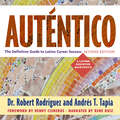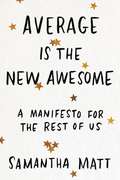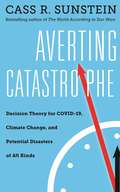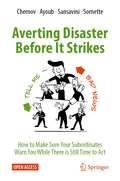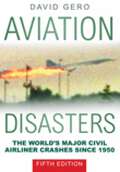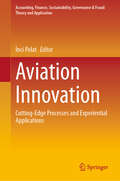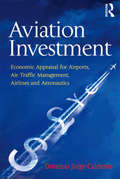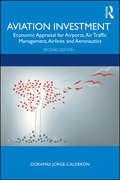- Table View
- List View
Auténtico: The Definitive Guide to Latino Career Success (A Latino Executive Manifesto)
by Robert Rodriguez Andrés T. TapiaAmerica has an urgent need for Latino and Latina executives. This book identifies a path to uplift and amplify their representation in leadership.Latinos and Latinas will account for a third of our workforce by 2050-yet they make up only 5 percent of senior roles in corporate America.Dr. Robert Rodriguez and Andr√©s T. Tapia call this low percentage of Latino and Latina corporate executives today the ‚Äú5 percent Shame.‚Äù Inspired by Price M. Cobbs's seminal work on the secrets of successful Black leaders, this book seeks to understand the impact on Latinos and Latinas of the external forces of conscious and unconscious biases and of the internal forces of whether to assimilate or double down on their cultural identities in their quest to get ahead. The second edition features a new foreword by Henry Cisneros, former secretary of the Department of Housing and Urban Development, as well as updated statistics and graphs to represent how America's career landscape for Latinos has and has not changed and how to ensure Latinos can rise to their fullest potential.Using insights from in-depth interviews with twenty highly successful boomer Latino and Latina executives and focus groups with dozens of Gen X and millennial leaders, the authors have captured lessons about how these individuals chose their career paths, addressed challenges, and seized opportunities. The discussions are interpreted through the lenses of the authors' different personal experiences as Latino leaders in corporate America and synthesized as a guide for future leaders.
Außenhandel
by Clemens BüterDer Außenhandel nimmt heutzutage in vielen Unternehmen einen zentralen Stellenwert ein. Dieses Buch ist ein Fach- und Grundlagenlehrbuch des Außenhandels. Es erläutert den Ordnungsrahmen internationaler Handelsbeziehungen und gibt, darauf aufbauend, eine grundlegende Darstellung aller wesentlichen Teilgebiete und Zusammenhänge des Außenhandelsgeschäfts. Die 4. Auflage wurde vollständig überarbeitet und erweitert. Wichtige Neuerungen betreffen u.a. Neuregelungen des Außenwirtschafts- und Zollrechts, der internationalen Zahlungsbedingungen und der Außenhandelsfinanzierung sowie Weiterentwicklungen im Rahmen der Risikobesicherung im Außenhandel.
Außenhandel im Wandel: Festschrift zum 60. Geburtstag von Reinhard Moser
by Christoph Leitl Jonas F. PuckKaum ein Unternehmen ist nicht von internationalem Wettbewerb betroffen. Exporte, internationale Direktinvestitionen und multinationale Unternehmen sind nicht nur Schlagworte die sich täglich in den Medien finden, die Auswirkungen internationaler Unternehmensaktivität beeinflussen auch erheblich die betriebswirtschaftliche Forschung. Dieser Sammelband bietet einen Überblick über aktuelle Ansätze, Theorien und empirische Studien zu diesen Themen. Geschrieben von renommierten Wissenschaftlern und erfahrenen Praktikern macht das Buch den Leser in kompakter und kompetenter Weise mit den aktuellen Trends auf diesen Gebieten vertraut.
Außenhandel: Grundlagen internationaler Handelsbeziehungen
by Clemens BüterDieses Buch ist ein Fach- und Grundlagenbuch des Außenhandels. Es erläutert den Ordnungsrahmen internationaler Handelsbeziehungen und gibt darauf aufbauend eine grundlegende Darstellung aller wesentlichen Teilgebiete und Zusammenhänge des Außenhandelsgeschäfts.Die 5. Auflage wurde vollständig überarbeitet und erweitert. Wichtige Neuerungen betreffen Weiterentwicklungen der außenwirtschaftlichen Rahmenbedingungen, Neuregelungen des Außenwirtschafts- und Zollrechts, die neuen Incoterms® 2020 der Internationalen Handelskammer sowie Entwicklungen im elektronischen Datenaustausch über Außenhandelsdokumente. Auch die Fragen und Aufgaben am Ende eines jeden Kapitels wurden aktualisiert.
Availability of Credit and Secured Transactions in a Time of Crisis
by N. Orkun AkseliIn the light of the financial crisis, it has become clear that the globalisation of financial markets has not been matched by the globalisation of legal certainty relating to financial transactions. The ability to give security influences not only the cost of credit but also, in some cases, whether credit will be available at all. Increasing the availability and lowering the cost of credit can make an important contribution to international and domestic economic development. Assessing the international challenges posed by inefficient secured credit laws, this book explores how these can be overcome to facilitate credit through legal reforms. Leading authorities in the field address the key issues surrounding the availability of credit, the role of banks in economic development and financial crises, UNCITRAL's legislative efforts, and international organisations and financial institutions and their involvement in the reform of secured transactions law.
Avance De Marca: Transfomación De Una Idea Pequeña En Una Gran Idea
by Super Summaries Karen Angélica Malagón EspinosaLa creación de marcas es un proceso muy complicado; no solo implica poner un nombre y publicarlo sino que involucra seguir una serie de pasos con la finalidad de que la gente la conozca y compre los productos relacionados con dicha marca. En este libro el lector encontrará once capítulos relacionados con la creación de una marca y lo que hay que hacer para que la gente la consuma. Recomendaciones como crear un nombre, un logotipo, un diseño, un eslogan, entre otros se resumen en este libro además de consejos para relacionarse con la gente adecuada para que su negocio y su marca progresen.
Avatare im Gesundheitswesen: Wie Virtual Reality Medizin und Gesundheit revolutionieren wird (essentials)
by David Matusiewicz Vladimir Puhalac Jochen A. WernerIn Zukunft werden wir mit unserem eigenen Avatar mit dem behandelnden Arzt im Smart Hospital sprechen können – und das vom Wohnzimmer aus. Das klingt utopisch, ist allerdings schon Realität geworden. Das essential beschäftigt sich mit der Frage, welchen Effekt Virtual Reality und die Avatare im Gesundheitswesen, der Medizin und in der Psychologie haben werden. Durch die praktische Erfahrung der Autoren können tiefgreifende Einblicke in eine exponentielle Technologie gegeben werden.
Avaya (A)
by David B. GodesAvaya's top management wants to improve demand generation. This requires an improvement in the relationship between Sales and Marketing. This case series (Avaya (A)-(D)) walks the student through each phase of this process. The (A) case begins with background on the firm, and asks the student to come up with a strategy to improve the way in which Sales and Marketing work together. In the (B) case, we see their strategy in the form of a "unified funnel" and a demand generation framework. The unified funnel communicates the idea that not only should the marketing funnel and the sales funnel be linked "vertically"--in the sense that Marketing's leads should flow seamlessly into Sales' funnel--but they should also be integrated horizontally. This latter point refers to the idea that Sales and Marketing should each play a role in each phase of the process from email marketing solutions right through to the close. That is, they argue that the two functions are best integrated by encouraging them to work simultaneously, not just sequentially. The demand generation framework, on the other hand, makes explicit what it means for them to work together. For example, they stipulate that Marketing should be included on the weekly sales conference call. The students are then asked to think about how they would implement these ideas. In the (C) case, the implementation plan for a specific market--Brazil--is described. In particular, we are given data that were used in the roll-out process that showed the market's managers how they compared with other markets on a number of dimensions. Finally, the (D) case shows some early data suggesting that this new method of working together has had a significant impact.
Avaya (B)
by David B. GodesAvaya's top management wants to improve demand generation. This requires an improvement in the relationship between Sales and Marketing. This case series (Avaya (A)-(D)) walks the student through each phase of this process. The (A) case begins with background on the firm and asks the student to come up with a strategy to improve the way in which Sales and Marketing work together. In the (B) case, we see their strategy in the form of a "unified funnel" and a demand generation framework. The unified funnel communicates the idea that not only should the marketing funnel and the sales funnel be linked "vertically"--in the sense that Marketing's leads should flow seamlessly into Sales' funnel--but they should also be integrated horizontally. This latter point refers to the idea that Sales and Marketing should each play a role in each phase of the process from email marketing solutions right through to the close. That is, they argue that the two functions are best integrated by encouraging them to work simultaneously, not just sequentially. The demand generation framework, on the other hand, makes explicit what it means for them to work together. For example, they stipulate that Marketing should be included on the weekly sales conference call. The students are then asked to think about how they would implement these ideas. In the (C) case, the implementation plan for a specific market--Brazil--is described. In particular, we are given data that were used in the roll-out process that showed the market's managers how they compared with other markets on a number of dimensions. Finally, the (D) case shows some early data suggesting that this new method of working together has had a significant impact.
Avaya (C): Implementing Demand Generation in Brazil
by David B. GodesAvaya's top management wants to improve demand generation. This requires an improvement in the relationship between Sales and Marketing. This case series (Avaya (A)-(D)) walks the student through each phase of this process. The (A) case begins with background on the firm and asks the student to come up with a strategy to improve the way in which Sales and Marketing work together. In the (B) case, we see their strategy in the form of a "unified funnel" and a demand generation framework. The unified funnel communicates the idea that not only should the marketing funnel and the sales funnel be linked "vertically"--in the sense that Marketing's leads should flow seamlessly into Sales' funnel--but they should also be integrated horizontally. This latter point refers to the idea that Sales and Marketing should each play a role in each phase of the process from email marketing solutions right through to the close. That is, they argue that the two functions are best integrated by encouraging them to work simultaneously, not just sequentially. The demand generation framework, on the other hand, makes explicit what it means for them to work together. For example, they stipulate that Marketing should be included on the weekly sales conference call. The students are then asked to think about how they would implement these ideas. In the (C) case, the implementation plan for a specific market--Brazil--is described. In particular, we are given data that were used in the roll-out process that showed the market's managers how they compared with other markets on a number of dimensions. Finally, the (D) case shows some early data suggesting that this new method of working together has had a significant impact.
Avaya (D): Early Results of Demand Generation
by David B. GodesAvaya's top management wants to improve demand generation. This requires an improvement in the relationship between Sales and Marketing. This case series (Avaya (A)-(D)) walks the student through each phase of this process. The (A) case begins with background on the firm and asks the student to come up with a strategy to improve the way in which Sales and Marketing work together. In the (B) case, we see their strategy in the form of a "unified funnel" and a demand generation framework. The unified funnel communicates the idea that not only should the marketing funnel and the sales funnel be linked "vertically"--in the sense that Marketing's leads should flow seamlessly into Sales' funnel--but they should also be integrated horizontally. This latter point refers to the idea that Sales and Marketing should each play a role in each phase of the process from email marketing solutions right through to the close. That is, they argue that the two functions are best integrated by encouraging them to work simultaneously, not just sequentially. The demand generation framework, on the other hand, makes explicit what it means for them to work together. For example, they stipulate that Marketing should be included on the weekly sales conference call. The students are then asked to think about how they would implement these ideas. In the (C) case, the implementation plan for a specific market--Brazil--is described. In particular, we are given data that were used in the roll-out process that showed the market's managers how they compared with other markets on a number of dimensions. Finally, the (D) case shows some early data suggesting that this new method of working together has had a significant impact.
Aventis SA (A): Planning for a Merger
by Carin-Isabel Knoop Joshua D. MargolisEight executives at Hoechst and Rhone-Poulenc must make four crucial decisions on the eve of merging their companies to become Aventis--what would become the world's third largest pharmaceutical firm. In addition to formulating a vision and strategy, the two firms must plot their intensified efforts in the U.S. market, pick a leader, and choose between two approaches to research and development. The merger represents the ongoing efforts of the two predecessor companies to remake themselves into life science companies. They face a range of pressures, from falling prices and intensifying demands on R&D for blockbuster pharmaceuticals to union opposition to the merger, skepticism from research analysts, and regulatory scrutiny. Amid these pressures, they must combine national and corporate cultures, merge into a single entity, and deliver the promised synergies. Concludes with a surprising development, when one of Hoechst's major shareholders objects to the merger.
Average Is Over
by Tyler CowenWidely acclaimed as one of the world’s most influential economists, Tyler Cowen returns with his groundbreaking follow-up to the New York Times bestseller The Great Stagnation. The widening gap between rich and poor means dealing with one big, uncomfortable truth: If you’re not at the top, you’re at the bottom. The global labor market is changing radically thanks to growth at the high end-and the low. About three quarters of the jobs created in the United States since the great recession pay only a bit more than minimum wage. Still, the United States has more millionaires and billionaires than any country ever, and we continue to mint them. In this eye-opening book, renowned economist and bestselling author Tyler Cowen explains that phenomenon: High earners are taking ever more advantage of machine intelligence in data analysis and achieving ever-better results. Meanwhile, low earners who haven’t committed to learning, to making the most of new technologies, have poor prospects. Nearly every business sector relies less and less on manual labor, and this fact is forever changing the world of work and wages. A steady, secure life somewhere in the middle-average-is over. With The Great Stagnation, Cowen explained why median wages stagnated over the last four decades; in Average Is Over he reveals the essential nature of the new economy, identifies the best path forward for workers and entrepreneurs, and provides readers with actionable advice to make the most of the new economic landscape. It is a challenging and sober must-read but ultimately exciting, good news. In debates about our nation’s economic future, it will be impossible to ignore. .
Average Joe: Be the Silicon Valley Tech Genius
by Shawn LivermoreThe book covers numerous tech entrepreneurial founders and software developers, and the exciting brands or products that they created. It goes deep on a handful of them, narrowly divulging exactly how a few software developers and startup founders created breakthrough tech products like Gmail, Dropbox, Ring, Snapchat, Bitcoin, Groupon, and more. It highlights and unpacks the general hero-worship that the media and our own minds practice about tech founders and tech entrepreneurs. This idealization of tech success can create a paradox, preventing average tech professionals from their own successful journeys. This book provides hard evidence that anyone in tech can create, and anyone on the peripheral of tech can break through to the center where innovation, creativity, and opportunity meet. The anecdotes, stories, evidence, facts, arguments, logic, principles, and techniques provided in this book have helped individuals and businesses engage in slow creation cycles, improve the morale of their development teams, and increased their delivery potential of their technology solutions overall. Average Joe covers: Genius - The systematic deconstruction and debunking of the commonly held assumptions in the tech industry around supreme intelligence, and how that intelligence has been worshipped and sought after, despite the facts. Slow Creation - How to force-manufacture creative ideation. How conscious and subconscious cycles of patterns, details, and secrets can lead to breakthrough innovations, and how those P.D.S. cycles, and systematic mental grappling, can be conjured and repeated on a regular basis. Little-C Creativity - The conscious and miniature moments of epiphany that leak into our active P.D.S. cycles of Slow Creation. Flow - Why it's great, but also - why it's completely unreliable and unnecessary. How to perpetually innovate without relying on a flow state. Team Installation - How teams and companies can engage their employees in Slow Creation to unlock dormant ideas, stir up creative endeavors, and jumpstart fragile ideas into working products. User Manipulation - How tech products are super-charged with tricks, secret techniques, and neural transmitters like Dopamine, Oxytocin, and Cortisol; how those products leverage cognitive mechanisms and psychological techniques to force user adoption and user behaviors. Contrarianism - How oppositional and backward-thinking leaders create brand-new categories and the products which dominate those categories. Showmanship - How tech players have presented their ideas to the world, conjured up magic, manufactured mystique, and presented compelling stories that have captured their audiences. Sustainable Mystique Triad – A simple model for capturing audiences consistently without relying on hype and hustle.
Average is the New Awesome: A Manifesto for the Rest of Us
by Samantha MattA celebration of ordinary awesomeness, for all of us who were told "You can do anything!" and then found out we actually can'tCrappy homes, lame love lives, getting passed over for a great job (again)--not what we expected for our adulthoods. Americans tell their children you can become anything! But let's face it--most of us can't. Sure, some of our peers go on to become astronauts or billionaires. But most of us don't. In Average Is the New Awesome, Samantha Matt offers encouragement to us regular humans. Full of hilarious stories and insightful advice, this is a manifesto for ordinary awesomeness--for the beauty that can be found when we acknowledge that good enough really is good enough, and that greatness is ours to define.
Averting Catastrophe: Decision Theory for COVID-19, Climate Change, and Potential Disasters of All Kinds
by Cass R SunsteinThe New York Times–bestselling author of Nudge and The World According to Star Wars examines how governments handle worst-case scenarios. The world is increasingly confronted with new challenges related to climate change, globalization, disease, and technology. Governments are faced with having to decide how much risk is worth taking, how much destruction and death can be tolerated, and how much money should be invested in the hopes of avoiding catastrophe. Lacking full information, should decision-makers focus on avoiding the most catastrophic outcomes? When should extreme measures be taken to prevent as much destruction as possible?Averting Catastrophe explores how governments ought to make decisions in times of imminent disaster. Cass R. Sunstein argues that using the &“maximin rule,&” which calls for choosing the approach that eliminates the worst of the worst-case scenarios, may be necessary when public officials lack important information, and when the worst-case scenario is too disastrous to contemplate. He underscores this argument by emphasizing the reality of &“Knightian uncertainty,&” found in circumstances in which it is not possible to assign probabilities to various outcomes. Sunstein brings foundational issues in decision theory in close contact with real problems in regulation, law, and daily life, and considers other potential future risks. At once an approachable introduction to decision-theory and a provocative argument for how governments ought to handle risk, Averting Catastrophe offers a definitive path forward in a world rife with uncertainty.
Averting Disaster Before It Strikes: How to Make Sure Your Subordinates Warn You While There is Still Time to Act
by Didier Sornette Dmitry Chernov Ali Ayoub Giovanni SansaviniSome of the major industrial disasters could have been prevented. When the facts of what happened are established, their stories share a common thread: before things spiralled out of control, there were workers at the affected sites who knew that the situation was dangerous, and could become catastrophic unless immediate action was taken. But tragically, nobody dared to tell the decision-makers who could have authorized that action. With no idea of the risks they were taking, the people in charge continued as normal… and disaster struck. Because vital information about risks could not flow freely from the shop floor to the director’s office, the crucial decisions were not made in time. This observation has been documented in the following major technological accidents: Challenger space shuttle explosion (USA, 1986); Chernobyl nuclear plant disaster (USSR, 1986); Deepwater Horizon oil spill (USA, 2010); Fukushima-1 nuclear power plant disaster (Japan, 2011); and numerous other industrial disasters. After accidents like these, losses and costs for dealing with the consequences are often hundreds — or even thousands — of times greater than the finances that would have been required to deal with the risks when they were first recognized.This handbook is about how to transform the way large critical infrastructure companies communicate about safety and technological risks. It aims to support senior managers to get the information they need from their subordinates concerning the risks they are facing, in order to prevent accidents before it is too late.The recommendations in this handbook are based on interviews with 100 executives at various levels, working in 65 critical infrastructure companies around the world, in power, oil and gas, metals, chemicals and petrochemicals, mining and other industries.The recommendations of these leaders were also tested in the pilot project, in an industrial company which is the world leader in its sector. More than 400 managers at various levels of the corporate hierarchy, and employees at several of the company’s industrial plants, took part in the project.This open access handbook is written for the owners, senior managers, and industrial safety directors of critical infrastructure companies.
Aviation Communication: Strategy and Messages for Ensuring Success and Preventing Failures
by Linda J. TavlinDo you ever wonder why an airline’s communication strategy can crash and burn in a crisis? A lack of understanding an acceptable aviation communication strategy can, in this fast world of social media, ruin a company’s credibility in the aviation industry. Aviation Communication: Strategy and Messages for Ensuring Success and Preventing Failures is the first go-to book to reveal to everyone in the aviation industry how to stop an organization’s communication strategy from becoming the tragedy-after-the-tragedy that we’ve seen so often. In such instances, after the media go home, the economic, political, regulatory, and legal effects can linger for years. The strategies and messages in this book show how to prevent this along with the ultimate safety net used by those who have been successful. Readers will learn to prevent catastrophic communication mistakes with strategic templates for a wide array of scenarios, as well as 25 specific techniques that give the actual words to use to deliver the book’s messages. This book is a must-have for the international aviation business community as a tri-functional induction, training, and reference tool.
Aviation Disasters: The World’s Major Civil Airliner Crashes Since 1950
by David GeroFlying as an airline passenger is, statistically, one of the safest forms of travel. Even so, the history of civil aviation is littered with high-profile disasters involving major loss of life. This new edition of the authoritative work on the subject brings the grim but important story of air disasters right up to date. David Gero assembles a list of major air disasters since the 1950s across continents. He investigates every type of calamity, including those caused by appalling weather, mechanical failure, pilot error, inhospitable terrain and hostile action. The first incident of sabotage involving a commercial jetliner is covered, as is the first, much-feared crash of the jumbo jet era. Examined alongside less well-known disasters are high-profile episodes such as that of Pan American Flight 103 at Lockerbie in 1988, the Twin Towers tragedy of 11 September 2001 and, more recently, the disappearance of Malaysia Airlines Flight 370 in 2014 – the greatest mystery of the commercial jet age. Aviation Disasters is the authoritative record of air disasters worldwide, fully illustrated with a fascinating selection of photographs.
Aviation Innovation: Cutting-Edge Processes and Experiential Applications (Accounting, Finance, Sustainability, Governance & Fraud: Theory and Application)
by İnci PolatThis book is a comprehensive exploration of how the aviation sector is leveraging innovation to address these pressing challenges. It delves into the transformative role of cutting-edge processes and experiential strategies in shaping the industry's future. Drawing on a blend of theoretical frameworks and real-world applications, the book examines how aviation stakeholders embrace advanced technologies, rethink traditional business models, and foster creative problem-solving approaches to deliver exceptional value.
Aviation Investment: Economic Appraisal for Airports, Air Traffic Management, Airlines and Aeronautics
by Doramas Jorge-CalderonAviation Investment uniquely addresses investment appraisal methods across the key industries that make up the aviation sector, including the airports, air traffic management, airline and aircraft manufacturing - or aeronautic - industries. It is a practice-oriented book where methods are presented through realistic case studies. The emphasis is on economic appraisal, or cost-benefit analysis, in order to determine the viability of projects not only for private investors but for society as a whole. Financial (cash flow) appraisal is illustrated alongside economic appraisal, as the latter builds on the former, but also to show how economic appraisal enhances standard financial appraisal to determine the long-term sustainability of any investment. Aviation is a capital-intensive sector that is growing rapidly, with world traffic expected to double over the next 15 years or so. A great deal of economic appraisal of investment projects takes place already, as aviation is subject to government intervention through economic regulation and financial support, and as both investors and policy makers seek to understand issues such as how environmental legislation may impact the viability of investments. Both economic growth and welfare go hand in hand with sound investment decisions, particularly regarding sectors such as aviation where investments are large and almost invariably debt-financed. Aviation Investment offers all aviation sub-sectors a single-source reference, bringing together the theoretical background of the economic appraisal literature and aviation investment in practice. It is written in a style that is accessible to non-academic professionals, using formulae only where strictly necessary to enable practical applications, and benefits from the substantial practical experience of the author.
Aviation Investment: Economic Appraisal for Airports, Air Traffic Management, Airlines and Aeronautics
by Doramas Jorge-CalderónAviation Investment uniquely addresses investment appraisal methods across the key industries that make up the aviation sector, including the airports, air traffic management, airline and aircraft manufacturing – or aeronautic – industries. This practice-oriented book presents methods through realistic case studies. It covers both economic appraisal, or cost-benefit analysis, measuring the value of projects to society, and financial appraisal, valuing projects as cash generators. This substantially expanded second edition covers in greater detail the treatment of environmental emissions, paying particular attention to climate change. It addresses the treatment of Market-Based Mechanisms (MBMs), including cap and trade systems like ETS and offset systems like CORSIA, and compares them to environmental taxes. It also addresses the adjustments needed to measure the foreign exchange generating value of projects, relevant in the presence of trade barriers. The new edition includes two new project types. One is airport relocations, perhaps the most complex type of airport projects, where the economic case is often more nuanced than may be apparent. The second is the re-introduction of supersonic travel. Aviation Investment offers all aviation sub-sectors a single-source reference, bringing together the theoretical background of the economic appraisal literature and aviation investment in practice. It is written in a style that is accessible to non-academic professionals, using formulae only where strictly necessary to enable practical applications, and benefits from the substantial practical experience of the author.
Aviation Landmarks - Norfolk and Suffolk
by Peter B. GunnNorfolk and Suffolk are bursting with aviation heritage, having played key roles in military aviation through the two world wars and beyond. The obvious notable landmarks include airfields past and present, traces of former radar stations, decoy airfields and other sites that were once highly secretive. However, there are less conspicuous ones too – from churches, memorials and museums to local pubs, streets and even village signs.This new edition of Aviation Landmarks: Norfolk and Suffolk offers a fully updated account of aviation heritage and history right up to the present day. With over 500 entries, it covers nearly seventy airfields as well as many lesser-known landmarks such as former radar stations, country houses, local heritage collections, street signs and more. Complete with illustrations, OS grid references and an index of places, this reference guide to the two counties, both in the air and on the ground, will captivate both interested locals and aviation enthusiasts alike.
Aviation Leadership: The Accountable Manager (Managing Aviation Operations)
by Mark J. PierottiThis book identifies the responsibilities of management in the regulatory territories of the FAA (USA), the EASA (European Union) and the GCAA (UAE), identifying the daily challenges of leadership in ensuring their company is meeting the regulatory obligations of compliance, safety and security that will satisfy the regulator while also meeting the fiducial responsibilities of running an economically viable and efficient lean company that will satisfy the shareholders. Detailing each responsibility of the Accountable Manager, the author breaks them down to understandable and achievable elements where methods, systems and techniques can be applied to ensure the role holder is knowledgeable of accountabilities and is confident that they are not only compliant with the civil aviation regulations but also running an efficient and effective operation. This includes the defining of an Accountable Manager "tool kit" as well as possible software "dashboards" that focus the Accountable Manager on the important analytics, such as the information and data available, as well as making the maximum use of their expert post holder team. This book will be of interest to leadership of all aviation- related companies, such as airlines, charter operators, private and executive operators, flying schools, aircraft and component maintenance facilities, aircraft manufacturers, engine manufacturers, component manufacturers, regulators, legal companies, leasing companies, banks and finance houses, departments of transport, etc; any relevant organisation regulated and licensed by civil aviation authority. It can also be used by students within a wide range of aviation courses at colleges, universities and training academies.
